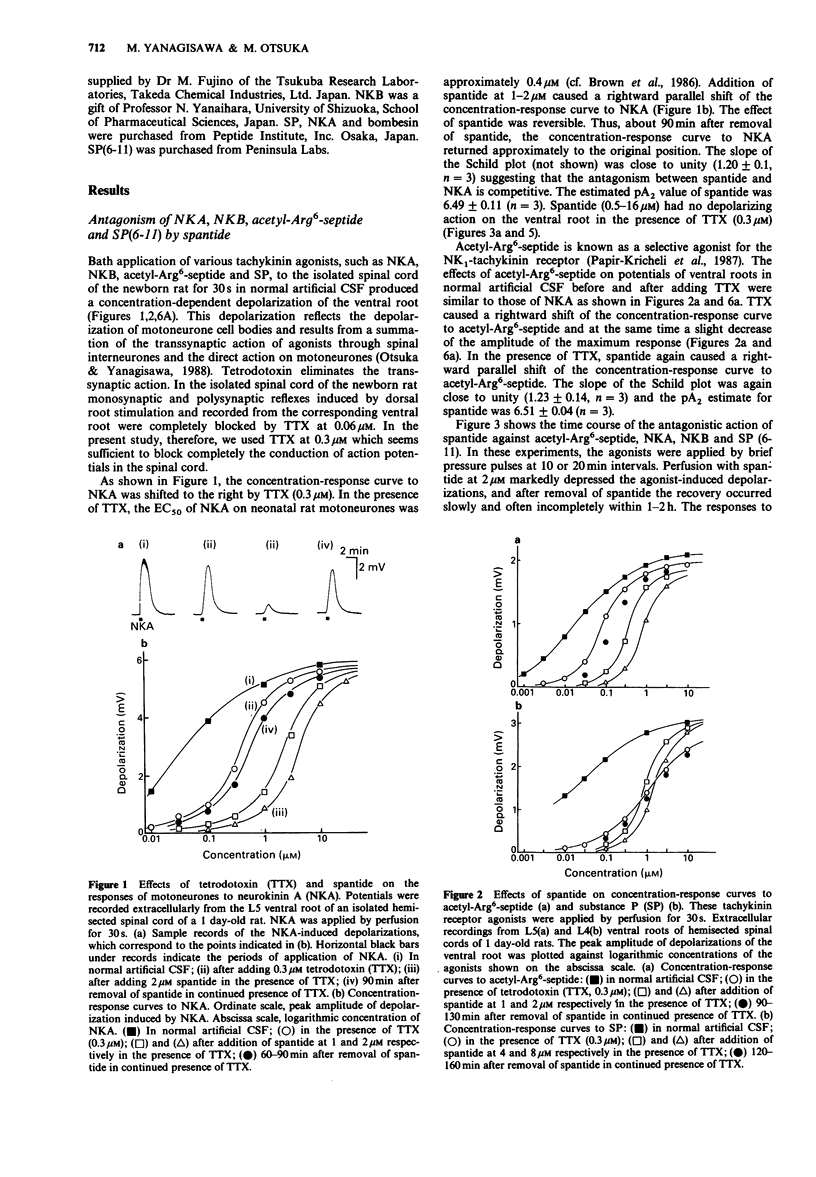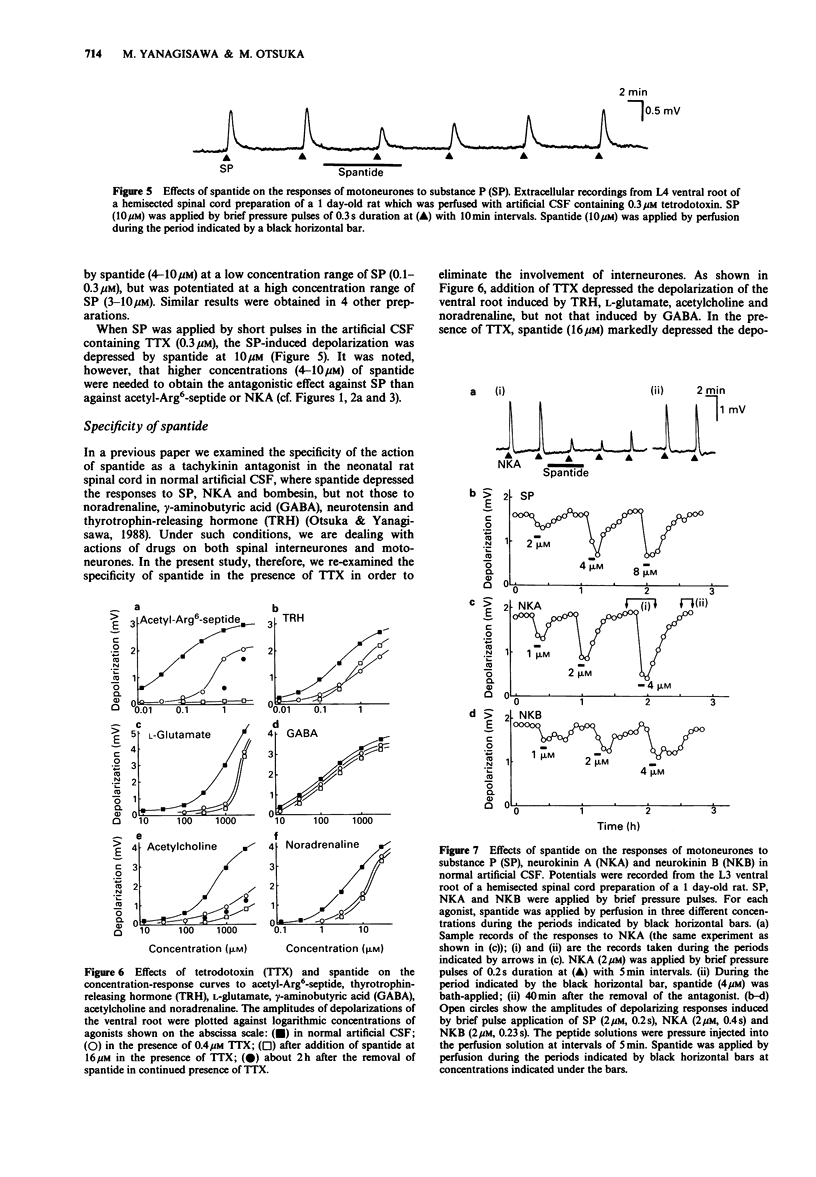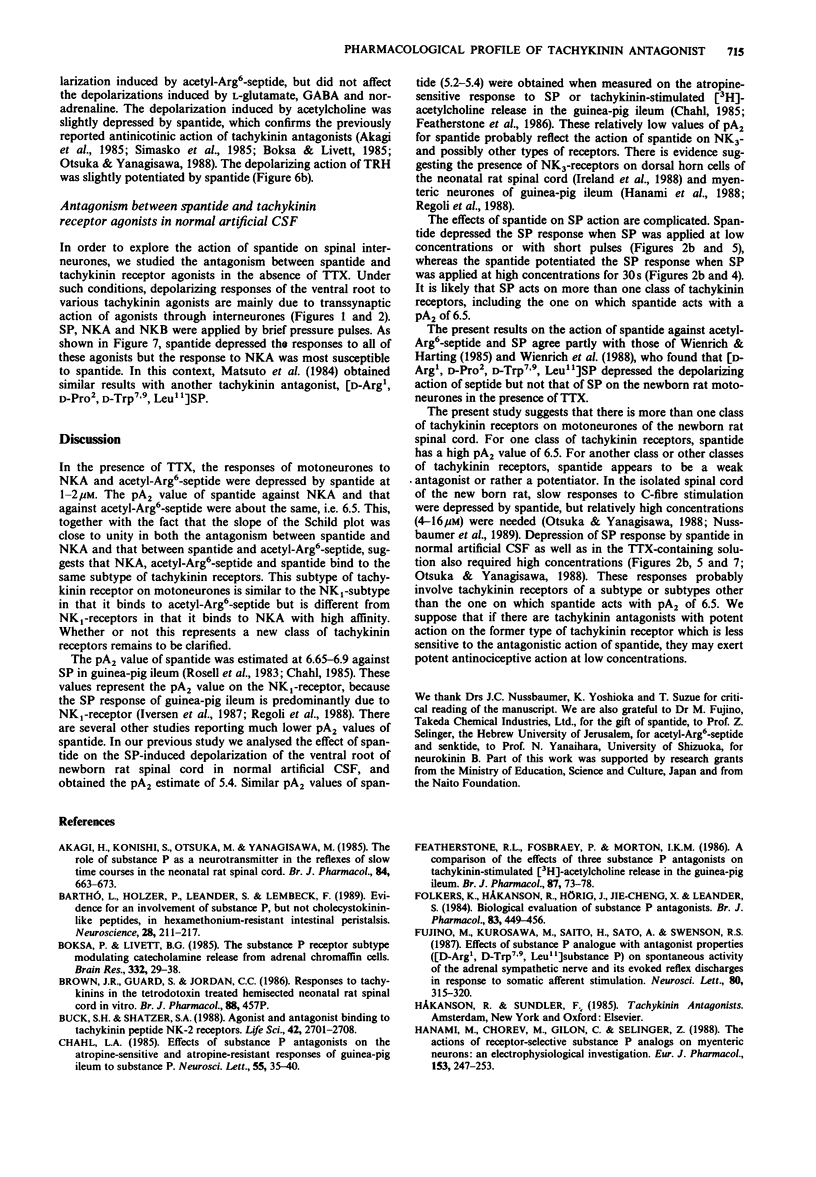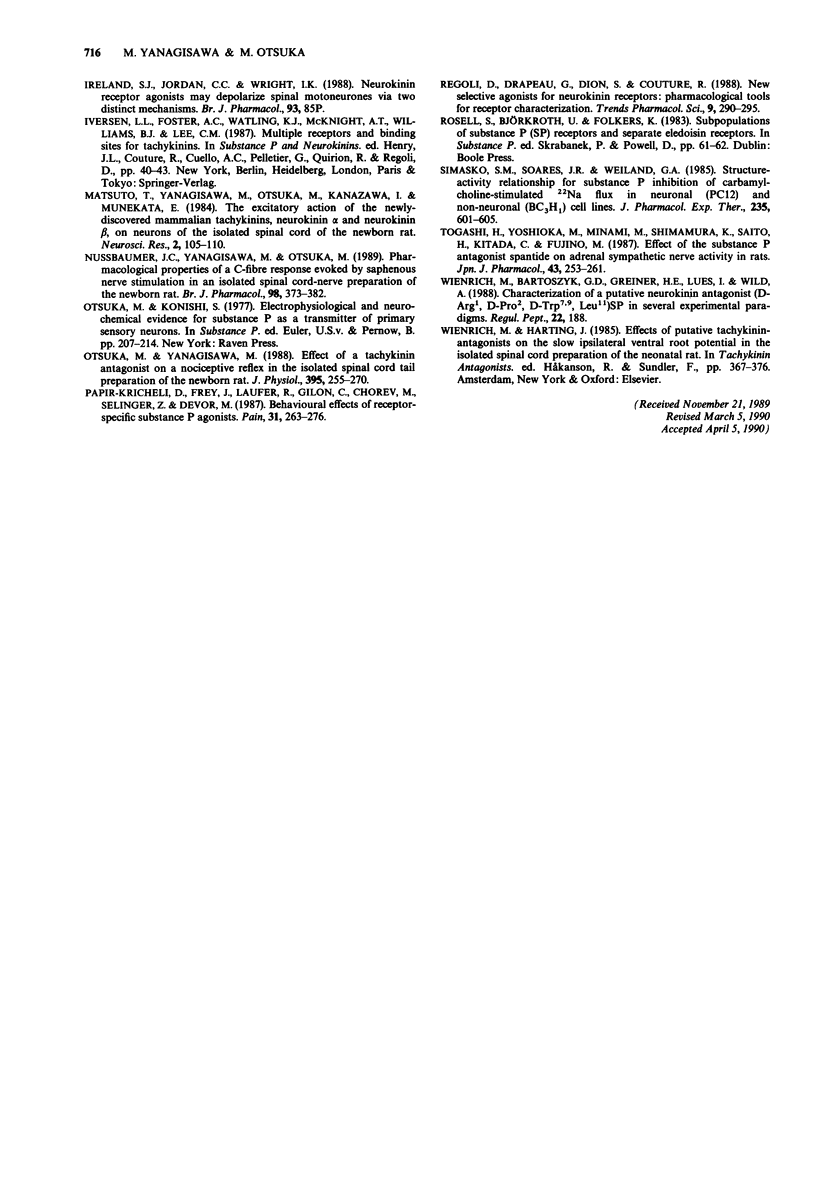Abstract
1. The pharmacological profile of a tachykinin antagonist, [D-Arg1, D-Trp7,9, Leu11] substance P (spantide), was studied on motoneurones of the isolated spinal cord of the newborn rat. For this purpose, potentials were recorded from a lumbar ventral root extracellularly and drugs were bath-applied in the presence of tetrodotoxin (TTX). 2. Neurokinin A (NKA), a NK2-receptor selective agonist, induced concentration-dependent depolarizations, which were antagonized by spantide. Analyses of concentration-response curves suggested a competitive type antagonism with a pA2 of 6.5. 3. Depolarizations induced by acetyl-Arg6-septide, a NK1-receptor selective agonist, were also antagonized by spantide with a pA2 of 6.5. 4. Spantide (0.5-16 microM) had no depolarizing action on the ventral root in the presence of TTX. 5. Spantide antagonized the depolarizing action of substance P (SP) when SP was applied at low concentrations (0.1-0.3 microM) or by short duration pulses in artificial cerebrospinal fluid containing TTX, but much higher concentrations of spantide (4-10 microM) were needed to exert an antagonistic action against SP than against acetyl-Arg6-septide or NKA. 6. Thyrotrophin-releasing hormone, L-glutamate, GABA, and noradrenaline, also induced depolarizations of the ventral root in the presence of TTX but the responses to these agonists were not depressed by spantide (16 microM). 7. These results suggest that there is a subtype of tachykinin receptors on neonatal rat spinal motoneurones to which NKA, acetyl-Arg6-septide and spantide bind competitively with high affinity.(ABSTRACT TRUNCATED AT 250 WORDS)
Full text
PDF





Selected References
These references are in PubMed. This may not be the complete list of references from this article.
- Akagi H., Konishi S., Otsuka M., Yanagisawa M. The role of substance P as a neurotransmitter in the reflexes of slow time courses in the neonatal rat spinal cord. Br J Pharmacol. 1985 Mar;84(3):663–673. doi: 10.1111/j.1476-5381.1985.tb16148.x. [DOI] [PMC free article] [PubMed] [Google Scholar]
- Barthó L., Holzer P., Leander S., Lembeck F. Evidence for an involvement of substance P, but not cholecystokinin-like peptides, in hexamethonium-resistant intestinal peristalsis. Neuroscience. 1989;28(1):211–217. doi: 10.1016/0306-4522(89)90245-5. [DOI] [PubMed] [Google Scholar]
- Battistella A., Boarato E., Bruni A., Mietto L., Palatini P., Toffano G. Apomorphine-induced inhibition of histamine release in rat peritoneal mast cells. Br J Pharmacol. 1986 Jun;88(2):457–462. doi: 10.1111/j.1476-5381.1986.tb10224.x. [DOI] [PMC free article] [PubMed] [Google Scholar]
- Boksa P., Livett B. G. The substance P receptor subtype modulating catecholamine release from adrenal chromaffin cells. Brain Res. 1985 Apr 15;332(1):29–38. doi: 10.1016/0006-8993(85)90386-5. [DOI] [PubMed] [Google Scholar]
- Buck S. H., Shatzer S. A. Agonist and antagonist binding to tachykinin peptide NK-2 receptors. Life Sci. 1988;42(26):2701–2708. doi: 10.1016/0024-3205(88)90246-9. [DOI] [PubMed] [Google Scholar]
- Chahl L. A. Effects of substance P antagonists on the atropine-sensitive and atropine-resistant responses of guinea-pig ileum to substance P. Neurosci Lett. 1985 Mar 22;55(1):35–40. doi: 10.1016/0304-3940(85)90308-8. [DOI] [PubMed] [Google Scholar]
- Featherstone R. L., Fosbraey P., Morton I. K. A comparison of the effects of three substance P antagonists on tachykinin-stimulated [3H]-acetylcholine release in the guinea-pig ileum. Br J Pharmacol. 1986 Jan;87(1):73–77. doi: 10.1111/j.1476-5381.1986.tb10158.x. [DOI] [PMC free article] [PubMed] [Google Scholar]
- Folkers K., Håkanson R., Hörig J., Xu J. C., Leander S. Biological evaluation of substance P antagonists. Br J Pharmacol. 1984 Oct;83(2):449–456. doi: 10.1111/j.1476-5381.1984.tb16506.x. [DOI] [PMC free article] [PubMed] [Google Scholar]
- Follenfant R. L., Hardy G. W., Lowe L. A., Schneider C., Smith T. W. Antinociceptive effects of the novel opioid peptide BW443C compared with classical opiates; peripheral versus central actions. Br J Pharmacol. 1988 Jan;93(1):85–92. doi: 10.1111/j.1476-5381.1988.tb11408.x. [DOI] [PMC free article] [PubMed] [Google Scholar]
- Fujino M., Kurosawa M., Saito H., Sato A., Swenson R. S. Effects of a substance P analogue with antagonist properties ([D-Arg1, D-Trp7,9, Leu11]substance P) on spontaneous activity of the adrenal sympathetic nerve and its evoked reflex discharges in response to somatic afferent stimulation. Neurosci Lett. 1987 Oct 5;80(3):315–320. doi: 10.1016/0304-3940(87)90474-5. [DOI] [PubMed] [Google Scholar]
- Hanani M., Chorev M., Gilon C., Selinger Z. The actions of receptor-selective substance P analogs on myenteric neurons: an electrophysiological investigation. Eur J Pharmacol. 1988 Aug 24;153(2-3):247–253. doi: 10.1016/0014-2999(88)90612-7. [DOI] [PubMed] [Google Scholar]
- Matsuto T., Yanagisawa M., Otsuka M., Kanazawa I., Munekata E. The excitatory action of the newly-discovered mammalian tachykinins, neurokinin alpha and neurokinin beta, on neurons of the isolated spinal cord of the newborn rat. Neurosci Res. 1984 Dec;2(1-2):105–110. doi: 10.1016/0168-0102(84)90008-7. [DOI] [PubMed] [Google Scholar]
- Nussbaumer J. C., Yanagisawa M., Otsuka M. Pharmacological properties of a C-fibre response evoked by saphenous nerve stimulation in an isolated spinal cord-nerve preparation of the newborn rat. Br J Pharmacol. 1989 Oct;98(2):373–382. doi: 10.1111/j.1476-5381.1989.tb12607.x. [DOI] [PMC free article] [PubMed] [Google Scholar]
- Otsuka M., Yanagisawa M. Effect of a tachykinin antagonist on a nociceptive reflex in the isolated spinal cord-tail preparation of the newborn rat. J Physiol. 1988 Jan;395:255–270. doi: 10.1113/jphysiol.1988.sp016917. [DOI] [PMC free article] [PubMed] [Google Scholar]
- Papir-Kricheli D., Frey J., Laufer R., Gilon C., Chorev M., Selinger Z., Devor M. Behavioural effects of receptor-specific substance P agonists. Pain. 1987 Nov;31(2):263–276. doi: 10.1016/0304-3959(87)90041-8. [DOI] [PubMed] [Google Scholar]
- Regoli D., Drapeau G., Dion S., Couture R. New selective agonists for neurokinin receptors: pharmacological tools for receptor characterization. Trends Pharmacol Sci. 1988 Aug;9(8):290–295. doi: 10.1016/0165-6147(88)90013-2. [DOI] [PubMed] [Google Scholar]
- Simasko S. M., Soares J. R., Weiland G. A. Structure-activity relationship for substance P inhibition of carbamylcholine-stimulated 22Na+ flux in neuronal (PC12) and non-neuronal (BC3H1) cell lines. J Pharmacol Exp Ther. 1985 Dec;235(3):601–605. [PubMed] [Google Scholar]
- Togashi H., Yoshioka M., Minami M., Shimamura K., Saito H., Kitada C., Fujino M. Effect of the substance P antagonist spantide on adrenal sympathetic nerve activity in rats. Jpn J Pharmacol. 1987 Mar;43(3):253–261. doi: 10.1254/jjp.43.253. [DOI] [PubMed] [Google Scholar]


